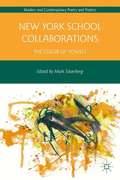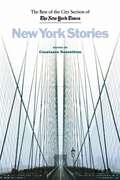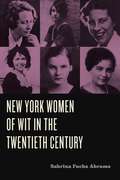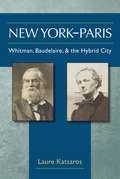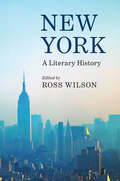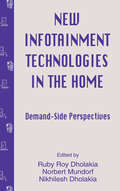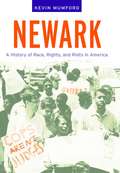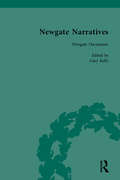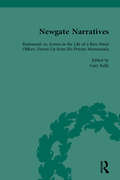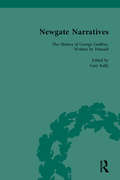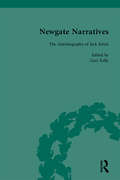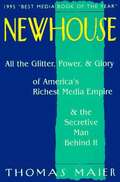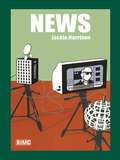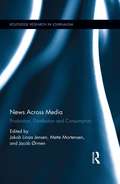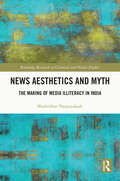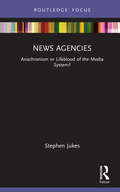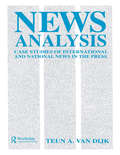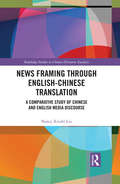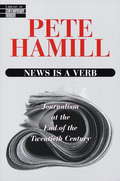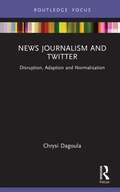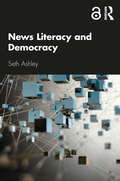- Table View
- List View
New York School Collaborations
by Mark SilverbergRanging from conceptual theater to visual poetry the New York School explored the possibilities of collaboration like no other group of American poets. New York School Collaborations gathers essays from a diverse group of scholars on the alliances and artistic co-productions of New York School poets, painters, musicians, and film-makers.
New York Stories: The Best of the City Section of the New York Times
by Constance RosenblumThese forty essays from the New York Times&’ City section tell &“stories of human life in all its quirky richness&” (The Boston Globe). Featuring a cast of stellar writers, this collection brings some of the best essays from the City section to readers beyond the five boroughs. New York Stories profiles people like sixteen-year-old Barbara Ott, who surfs the waters off Rockaway in Queens, and Sonny Payne, the beloved panhandler of the F train. Other essays explore memorable places, from the Greenwich Village townhouse blown up by radical activists in the 1970s to a basketball court that serves as the heart of its Downtown neighborhood. The forty essays collected here reflect an intimate understanding of the city, one that goes beyond the headlines. The result is a passionate, well-written portrait of a legendary and ever-evolving place. Contributors include: Andre Aciman, Thomas Beller, Laura Shaine Cunningham, Jim Dwyer, Jill Eisenstadt, Vivian Gornick, Chuck Klosterman, Robert Lipsyte, Phillip Lopate, Jan Morris, Richard Price, Joe Queenan, Suzanne Vega, Meg Wolitzer, and more &“Unassuming, elegant dispatches, suffused with a wise but unsentimental affection.&”—The New Yorker &“All of the pieces are engrossing . . . This is both an excellent addition to New York history and a pleasure for casual browsing.&” ―Publishers Weekly
New York Women of Wit in the Twentieth Century (Humor in America)
by Sabrina Fuchs AbramsSeen as too smart, too sassy, too sexy, and too strident, female humorists have been resisted and overlooked. New York Women of Wit in the Twentieth Century corrects this tendency, focusing on the foremothers of women’s humor in modern America, who used satire, irony, and wit as indirect forms of social protest.This book focuses on the women who stood on the periphery of predominantly male New York intellectual circles in the twentieth century. Sabrina Fuchs Abrams argues that the advent of modernism, the women’s suffrage movement, the emergence of the New Woman and the New Negro Woman, and the growth of urban centers in the 1920s and ’30s gave rise to a new voice of women’s humor, one that was at once defiant and conflicted in defining female identity and the underlying assumptions about gender roles in American society. Her study gives special attention to the contributions of the satirists Edna St. Vincent Millay (pseudonym Nancy Boyd), Tess Slesinger, Dorothy Parker, Jessie Redmon Fauset, Dawn Powell, and Mary McCarthy.Grounded in theories of humor, feminist and critical race theory, and urban studies, this book will find an audience among scholars and students interested in women writers, feminist humor, modern American literature, and African American studies.
New York-Paris: Whitman, Baudelaire, and the Hybrid City
by Laure KatsarosAs New York and Paris began to modernize, new modes of entertainment, such as panoramas, dioramas, and photography, seemed poised to take the place of the more complex forms of literary expression. Dioramas and photography were invented in Paris but soon spread to America, forming part of an increasingly universal idiom of the spectacle. This brave new world of technologically advanced but crudely mimetic spectacles haunts both Whitman's vision of New York and Baudelaire's view of Paris. In New York-Paris, Katsaros explores the images of the mid-nineteenth-century city in the poetry of both Whitman and Baudelaire and seeks to demonstrate that, by projecting an image of the other's city onto his own, each poet tried to resist the apparently irresistible forward momentum of modernity rather than create a paradigmatically happy mixture of "high" and "low" culture.
New York: A Literary History (Routledge Studies In First World War History Ser.)
by Ross WilsonNew York City's streets, parks, museums, architecture, and its people appear in an array of literary works published from New York's earliest settlement to the present day. The exploration of the city as both a symbol and as a reality has formed the basis of New York's literature. Using the themes of adaptation, innovation, identity, and hope, this history explores novels, poetry, periodicals, and newspapers to examine how New York's literature can be understood through the notion of movement. From the periodicals of the nineteenth century, the Arabic writers of the city in the early twentieth century, the literature of homelessness, childhood, and the spaces of tragedy and resilience within the metropolis, this diverse assessment opens up new areas of research within urban literature. It provides an innovative examination of how writing has shaped the lives of New Yorkers and how writing about the city has shaped the modern world.
New and Selected Poems, Volume One
by Mary OliverWhen New and Selected Poems, Volume One was originally published in 1992, Mary Oliver was awarded the National Book Award. In the fourteen years since its initial appearance it has become one of the best-selling volumes of poetry in the country. This collection features thirty poems published only in this volume as well as selections from the poet's first eight books.<P><P> Mary Oliver's perceptive, brilliantly crafted poems about the natural landscape and the fundamental questions of life and death have won high praise from critics and readers alike. "Do you love this world?" she interrupts a poem about peonies to ask the reader. "Do you cherish your humble and silky life?" She makes us see the extraordinary in our everyday lives, how something as common as light can be "an invitation/to happiness,/and that happiness,/when it's done right,/is a kind of holiness,/palpable and redemptive." She illuminates how a near miss with an alligator can be the catalyst for seeing the world "as if for the second time/the way it really is." Oliver's passionate demonstrations of delight are powerful reminders of the bond between every individual, all living things, and the natural world.<P> Winner of the National Book Award
New infotainment Technologies in the Home: Demand-side Perspectives (Routledge Communication Series)
by Ruby Roy Dholakia Nikhilesh Dholakia Norbert MundorfAs the "information superhighway" moves into the home through interactive media, enhanced telecom services, and hybrid appliances, interest continually grows in how consumers adopt and use Information Technology (IT), the strategies IT marketers use to reach consumers, and the public policies that help and protect consumers. USE COPY FROM THIS POINT ON FOR GENERAL CATALOGS... This book presents a unique collection of papers dealing with the demand side issues of new information technologies in the home. The contributors are from business, academia, and the public policy sector and represent many disciplines including communication, marketing, economics, psychology, engineering, and information systems. This book provides one of the best introductions to complex issues such as: * business forces that will shape "Home IT" of the future; * industry structure of the future "Infotainment" mega-business; * factors affecting consumer adoption and use of IT; * international differences in the management of the IT sector; and * public policies that will shape the deployment and use of IT.
Newark: A History of Race, Rights, and Riots in America
by Kevin MumfordNewark's volatile past is infamous. The city has become synonymous with the Black Power movement and urban crisis. Its history reveals a vibrant and contentious political culture punctuated by traditional civic pride and an understudied tradition of protest in the black community. Newark charts this important city's place in the nation, from its founding in 1666 by a dissident Puritan as a refuge from intolerance, through the days of Jim Crow and World War II civil rights activism, to the height of postwar integration and the election of its first black mayor. In this broad and balanced history of Newark, Kevin Mumford applies the concept of the public sphere to the problem of race relations, demonstrating how political ideas and print culture were instrumental in shaping African American consciousness. He draws on both public and personal archives, interpreting official documents--such as newspapers, commission testimony, and government records--alongside interviews, political flyers, meeting minutes, and rare photos. From the migration out of the South to the rise of public housing and ethnic conflict, Newark explains the impact of African Americans on the reconstruction of American cities in the twentieth century.
Newgate Narratives Vol 1
by Gary KellyPresents a representative body of Romantic and early Victorian crime literature. This work contains ephemeral material ranging from gallows broadsides to reports into prison conditions. It is suitable for those studying Literature, Romantic and Victorian popular culture, Dickens Studies and the History of Criminology.
Newgate Narratives Vol 2
by Gary KellyPresents a representative body of Romantic and early Victorian crime literature. This work contains ephemeral material ranging from gallows broadsides to reports into prison conditions. It is suitable for those studying Literature, Romantic and Victorian popular culture, Dickens Studies and the History of Criminology.
Newgate Narratives Vol 3
by Gary KellyPresents a representative body of Romantic and early Victorian crime literature. This work contains ephemeral material ranging from gallows broadsides to reports into prison conditions. It is suitable for those studying Literature, Romantic and Victorian popular culture, Dickens Studies and the History of Criminology.
Newgate Narratives Vol 4
by Gary KellyPresents a representative body of Romantic and early Victorian crime literature. This work contains ephemeral material ranging from gallows broadsides to reports into prison conditions. It is suitable for those studying Literature, Romantic and Victorian popular culture, Dickens Studies and the History of Criminology.
Newgate Narratives Vol 5
by Gary KellyPresents a representative body of Romantic and early Victorian crime literature. This work contains ephemeral material ranging from gallows broadsides to reports into prison conditions. It is suitable for those studying Literature, Romantic and Victorian popular culture, Dickens Studies and the History of Criminology.
Newhouse: All the Glitter, Power, and Glory of America's Richest Media Empire and the Secretive Man Behind It
by Thomas MaierThis book explores the history of the Newhouse family-a family that went from near poverty to amassing a media fortune of 13 billion. The Newhouse media empire includes influential magazines, book publishing houses, newspapers, and cable oulets. The book chronicles the Newhouse family story in a facinating must read style.
News
by Jackie HarrisonFrom an author highly knowledgeable in the field, News is a handy and accessible guide that examines the history of news, both as newspapers and radio, and as entertainment and information, and introduces students to the key concepts and issues that surround the news. Using up-to-date case examples such as the Hutton Report and embedded journalists, from across a range of media including print, radio, television and the internet, Jackie Harrison explains the different theoretical approaches that have been used to study the news, as well as providing an accessible introduction to how news is produced and regulated, what counts as news, and how it is selected and presented. Topics covered include: introduction to the concept of news the growth and development of news technology, concentration and competition balancing freedom and responisibility regulatory control of the news making the news. Written in a clear and lively style, News is the ideal introductory book for students of media, communication and journalism.
News Across Media: Production, Distribution and Consumption (Routledge Research in Journalism)
by Mette Mortensen Jakob Linaa Jensen Jacob ØrmenNews production, distribution and consumption are in rapidly changing due to the rise of new media. This book examines how these processes become more and more interrelated through logics of dissemination, sharing and co-production. These changes have the potential to affect the criteria of newsworthiness as well as existing power structures and relations within the fields of journalism and agenda setting. The book discusses changing logics of production, from citizens’ as well as journalists’ perspectives, examines distribution and sharing as a link between but also an intrinsic part of production and consumption, and addresses the changing logics of consumption. Contributors place such changes in a historical perspective and outline challenges and future research agendas.
News Aesthetics and Myth: The Making of Media Illiteracy in India (Routledge Research in Cultural and Media Studies)
by Shashidhar NanjundaiahThis book considers the presence of media illiteracy in a world in which we are supposedly consumed by media, live a media life, in a media ecosystem, surrounded by mediated communication.Unpacking this paradoxical situation, the author proposes that before venturing into media literacy, we must first understand the workings of how mystification occurs. Departing from the idea that aesthetics work on an agreed set of principles between art and society, the author applies this ideology of aesthetics to news-based narration. Using empirical cases from India, the author proposes demystification as a possible methodology to approach media illiteracy and recommends completely transformed media literacy programs that deliver to communities, drawing from the construct of critical pedagogy. The book offers the possibilities for a collectivistic, non-Western, postcolonialist model of learning by using the very collective and hierarchical identities of societies that must be critiqued.This vital and innovative book will be an important resource for scholars and students in the areas of media literacy and critical media literacy, media education, journalism, mass communication, aesthetics and media technology.
News Agencies: Anachronism or Lifeblood of the Media System? (Disruptions)
by Stephen JukesThis book explores the role of international news agencies and investigates whether they have been able to adapt to the contemporary media landscape following the disruption wrought by fake news, social media and an increasingly polarised public discourse. News Agencies addresses the key players in the industry, beginning with the ‘big three’ (Reuters, The Associated Press and Agence France-Presse) and then moving on to the newest global player, Bloomberg. It also explores the role of alternative providers of international news which are seeking to challenge the Western-centric perspective of the agencies. Drawing on interviews with senior editors, Jukes investigates the challenges agencies face in terms of their editorial strategy and business models in today’s social media context. At a time when there is widespread distrust in the media and agencies are relying increasingly on user-generated content as a source for news, Jukes critically explores the role of these agencies in the debate over fake news and policies on objectivity, impartiality and verification. Shedding light on a sector of the news industry that has steadfastly remained out of the public spotlight, this book will be of interest to students and academics in the fields of journalism and media studies.
News Analysis: Case Studies of international and National News in the Press (Routledge Communication Series)
by Teun A. van DijkFirst Published in 1987. Routledge is an imprint of Taylor & Francis, an informa company.
News Around the World: Content, Practitioners, and the Public
by Pamela J. Shoemaker Akiba A. CohenWhat's news? A front-page news story in the United States might not appear in a newspaper in China. Or a minor story on German television may be all over the airwaves in India. But News Around the World shows that the underlying nature of news is much the same the world over and that people--no matter what their jobs or their status in society--tend to hold similar notions of newsworthiness. In this richly detailed study of international news, news makers and the audience, the authors have undertaken exhaustive original research within two cities--one major and one peripheral--in each of ten countries: Australia, Chile, China, Germany, India, Israel, Jordan, Russia, South Africa, and the United States. The nations were selected for study based on a central principle of maximizing variation in geographic locations, economic and political systems, languages, sizes, and cultures. The remarkable scope of the research makes this the most comprehensive analysis of newsworthiness around the globe: 10 countries studied, each with a university country director 2 cities in each country examined, one major and one peripheral 60 news media studied (newspapers, television, and radio news programs), resulting in 32,000+ news items analyzed 80 focus groups with journalists, public relations practitioners, and audience members 2,400 newspaper stories ranked according to newsworthiness and compared with how prominently they were published. News Around the World provides remarkable insight into how and why news stories are reported, testing and improving a theory of cross-cultural newsworthiness and is essential reading for anyone seeking to understand international media and journalism.
News As Discourse (Routledge Communication Series)
by Teun A. van DijkFirst Published in 1990. Routledge is an imprint of Taylor & Francis, an informa company.
News Framing through English-Chinese Translation: A Comparative Study of Chinese and English Media Discourse (Routledge Studies in Chinese Discourse Analysis)
by Nancy Xiuzhi LiuNews Framing Through English-Chinese Translation provides a useful tool to depict how Chinese news translation can be examined in the era of globalization. The author has integrated framing theory in journalism studies with translation studies and developed a new theoretical model/framework named Transframing. This interdisciplinary model is pioneering and will make theoretical and conceptual contributions to translation studies. This book aims to reveal ideological, sociocultural and linguistic factors creating media discourse by examining Chinese media discourse, in comparison to its counterpart in English. Through the analysis of both quantitative and qualitative methods, it is concluded that the transframing model can be applied to interpreting, describing, explaining as well as predicting the practice of news translation.
News Is a Verb
by Pete Hamill"When screaming headlines turn out to be based on stories that don't support them, the tale of the boy who cried wolf gets new life. When the newspaper is filled with stupid features about celebrities at the expense of hard news, the reader feels patronized. In the process, the critical relationship of reader to newspaper is slowly undermined." --from NEWS IS A VERB. With the usual honorable exceptions, newspapers are getting dumber. They are increasingly filled with sensation, rumor, press-agent flackery, and bloated trivialities at the expense of significant facts. The Lewinsky affair was just a magnified version of what has been going on for some time. Newspapers emphasize drama and conflict at the expense of analysis. They cover celebrities as if reporters were a bunch of waifs with their noses pressed enviously to the windows of the rich and famous. They are parochial, square, enslaved to the conventional pieties. The worst are becoming brainless printed junk food. All across the country, in large cities and small, even the better nwspaper are predictable and boring. I once heard a movie director say of a certain screenwriter: 'He aspired to mediocrity, and he succeeded.' Many newspapers are succeeding in the same way.
News Journalism and Twitter: Disruption, Adaption and Normalisation (Disruptions)
by Chrysi DagoulaThis book provides a critical account of the impact of Twitter on journalism, exploring how the news media has adapted to and normalised the use of the platform in the industry. Offering a comprehensive understanding of Twitter uses for journalistic purposes, this book explores the platform’s use as a ‘global village’, as an ambient news environment, and as a global marketplace. Drawing on two empirical case studies (United Kingdom and Greece), Dagoula examines academic conceptualisations of Twitter, journalists’ self-perceptions, and uses of the platform by a variety of media outlets and journalists. Adopting an evolutionary approach known as punctuated equilibrium, which consists of three stages of disruption, adaption, and normalisation, the author reveals the costs and benefits of Twitter’s impact on both the institutional values and practices of news journalism today. News Journalism and Twitter is an invaluable resource for researchers and students of digital journalism and media studies.
News Literacy and Democracy
by Seth AshleyNews Literacy and Democracy invites readers to go beyond surface-level fact checking and to examine the structures, institutions, practices, and routines that comprise news media systems. This introductory text underscores the importance of news literacy to democratic life and advances an argument that critical contexts regarding news media structures and institutions should be central to news literacy education. Under the larger umbrella of media literacy, a critical approach to news literacy seeks to examine the mediated construction of the social world and the processes and influences that allow some news messages to spread while others get left out. Drawing on research from a range of disciplines, including media studies, political economy, and social psychology, this book aims to inform and empower the citizens who rely on news media so they may more fully participate in democratic and civic life. The book is an essential read for undergraduate students of journalism and news literacy and will be of interest to scholars teaching and studying media literacy, political economy, media sociology, and political psychology.
